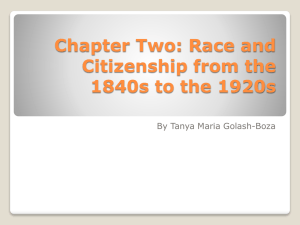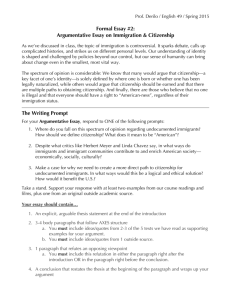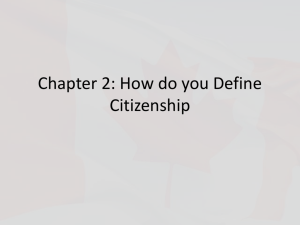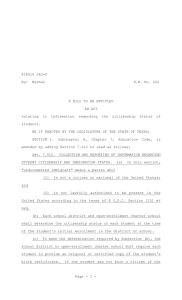Chapter_2_-_Race_and_Racisms__edited 5.1 MB
advertisement
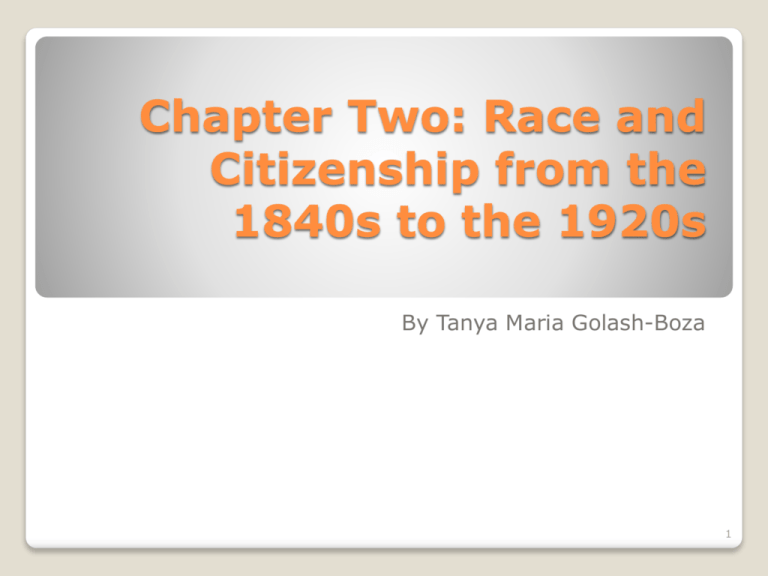
Chapter Two: Race and Citizenship from the 1840s to the 1920s By Tanya Maria Golash-Boza 1 People continue to make racial categories and give them meaning so the idea of race remains in circulation Describing race as a social, historical, and legal construction helps us view this categorizing process at work White is a privileged category in the U.S. racialized system. We can see this at work historically in immigration policy, birth-right citizenship, and naturalization We can explore how historically the boundaries of whiteness have been contested. Pertinent Ideas from Chapter One 2 Figure 2-1. Immigration to the United States, 1820–1940 Source: Office of Immigration Statistics, Department of Homeland Security. Figure 2-1: Office of Immigration Statistics, Department of Homeland Security Immigration policy and the laws determining who can become citizens drew on scientific racism. Scientific racism continues to influence some present day thinkers. Different groupings’ histories exemplify the trajectory of racialization through their entry into “whiteness.” Reasons to Examine the Immigration History of 1840–1924 4 This included comparative studies to measure human skulls from so-called racial groups and then assumptions that intelligence was associated with bigger skulls. Scientists used flawed methods to determine that whites were superior to any other group Scientific Racism Method for Measuring Intelligence: Craniometry 5 Intelligent testing Emerged for purposes of ranking Southern and Eastern European groups below Northern and Western groups Began by misappropriating an innocent test that was for bettering children’s education (Binet’s test) Used to determine a person’s or a group’s finite level of intelligence—the idea that they could not get any smarter Scientific Racism Method for Measuring Intelligence: Intelligence Testing 6 Many different kinds of intelligences exist. Intelligence cannot develop without education, resources, and nurturing. One score does not measure intelligence accurately. Intelligent tests can be culturally biased. Intelligence as a Nonmeasurable Entity 7 Eugenics was based on the assumption that characteristics such as intelligence, ambition, poverty, and law-breaking were inherited. Therefore people were divided into fit and unfit and actual sterilization programs were put into place to stop those determined to be “unfit” from having children. Nordics were at the top of the rankings as fit—this theory espoused by Madison Grant in the United States was utilized by Adolph Hitler in Nazi Germany in the 1930s. Scientific Racism Method for Measuring Intelligence: Eugenics 8 The Bell Curve in 1995—by Richard Hernstein and Charles Murray Race: The Reality of Human Difference (2004) by Frank Miele and Vincent Sarich Jason Richwine’s 2009 Ph.D. Dissertation, “IQ and Immigration Policy” Ideas about Inherent Inferiority of Groupings of People Continues Today 9 In the early 1900s, intelligence testing was done on Southern and Eastern immigrants to show their “deficient” intelligence. Madison Grant in writing The Passing of the Great Race and being part of a congressional committee on immigration spread his eugenic ideas. This lead to immigration quotas on the entrance of Southern and Eastern Europeans as immigrants due to their alleged “inferior” intelligence and behaviors. They were not as “white” as Nordic immigrants. Scientific Racism’s Influence on Immigration Policy 10 Chinese Exclusion Act of 1882 and renewals of this policy until 1952 ◦ Certificates of Residence mandated for Chinese and in 1928 legal identity documents required for other immigrants • Development of the Border Patrol Earlier Exclusions in Immigration Policies on the Basis of Race and Class 11 Immigration Act of 1917 expanded barriers for people from India, Burma, Malay States, Arabia, and Afghanistan 12 Johnson-Reed Act of 1924—Goal was to decrease the immigration of any European group that was not categorized as “Nordic” through quota system. Mexican immigration did not have quotas. Introduced passports and visas as mandatory. Immigration Exclusions Continue: Johnson-Reed Act of 1924 13 Based quotas on the U.S. population, but sent a message about who did not belong to the nation by not including four groups as part of the population numbers: Immigrants from the Western Hemisphere 2. Asians 3. Descendants of slaves 4. Native Peoples in the U.S. 1. Johnson-Reed Act of 1924 14 In 1790 only whites born in the United States benefited from birth-right citizenship (birth in the U.S. automatically transferred citizenship rights) The 14th Amendment to Constitution expanded it to blacks and whites in 1866 United States v. Wong Kim Ark (1898) added the right of citizenship to children born to non-citizens Birthright Citizenship: Racialized History 15 Between 1907 and 1931 women who married non-citizens and who could not naturalize or become citizens through a bureaucratic process lost their citizenship 1924 Native Americans gained birthright citizenship Nationality Act of 1940 anyone born in the U.S. was granted citizenship Birthright Citizenship: Racialized History 16 Individuals from multiple groups petitioned the court for citizenship from 1878 to 1952: Native American, Chinese, Hawaiian, Burmese, Japanese, Indian, Syrian, Armenian, Filipino, Arabian, Mexican, and mixed racial background They petitioned on the basis that they should be considered white. Naturalization: Racialized History 17 Two cases exemplify the way whiteness is a social and legal construct: Takao Ozawa v. United States (1922) United States v. Bhagat Singh Thind (1923) Naturalization: Racialized History 18 Takao Ozawa v. United States (1922)— The case determined that white skin did not make Ozawa, born in Japan, white because race science and common knowledge of the time determined that Ozawa was not white. Naturalization: Racialized History 19 United States v. Bhagat Singh Thind (1923) This case contradicted the way race science was used in Ozawa. Despite race science categorizations, Thind was not considered white by the courts because this idea did not match up with common ideas of who was white at the time. Naturalization: Racialized History 20 Today we acknowledge Irish, Italians, and Jews as white, but when large groupings of these ethnicities arrived they were not considered or thought of themselves as white Over time, through aligning themselves with white identities and not intervening but joining in on the oppression of blacks, they embraced white identities. Group Categorization Change: Irish, Italians, and Jews become White 21 After Emancipation and following the 1868 14th Amendment, a window of high levels of participation in government office characterized the African American community in the southern United States. Following this short window, a series of laws and terror organizations were established to disenfranchise African Americans. Struggle for Citizenship: African Americans and Native Americans from 1840–1940 22 African Americans faced Lynchings Terror by secret organizations like the Ku Klux Klan Poll taxes before being permitted to vote Representations as not being smart, but as good at manual labor Struggle for Citizenship: African Americans and Native Americans from 1840–1940 23 Cross burning at a Klan members’ meeting, circa 1900 Onlookers at the lynching of Thomas Smith and Abram Shipp, 7 August 1930, Marion, Indiana, USA Struggle for Citizenship Continues 24 Native Americans faced: Land taken Removal to reservations Reservation land allotted and the loss of two-thirds of reservation land base Forced boarding schools for children Assimilation policies Struggle for Citizenship: African Americans and Native Americans from 1840–1940 25 Whiteness permeates the history of immigration, citizenship, and naturalization White racial categorization has changed across time in social and legal settings Communities identified as “non-white” have historically struggled with legalized inequality and inequity Summary 26
